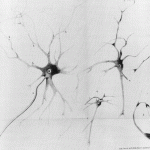
At the end of February I have a speaking engagement, during which I will explore the question “Social or Solo? Why Learning in Community Beats Learning alone”. I’ll be speaking for a graduate school audience at my alma mater, and I’m excited but a bit nervous.
As I’ve been reading to prepare for the gig, it occurred to me, “Oh! I can blog about this!! And invite others into my thinking process!” (Hmmmmm, sounds like social learning to me).
So here is my first stab at at exploring the question, “Is learning more social or solo?”
Neurons Firing in the Brain
The more I learn about neuroscience, the more I use brain-based explanations when I’m working with my academic coaching clients.
Just the other day I found myself saying to a kid, “Do you know what learning is?! It’s simply the process of burning new neuropathways in the brain!”
 I then drew drawings of dendrites and axons on the board, and tried to explain two points:
I then drew drawings of dendrites and axons on the board, and tried to explain two points:
(1) when we are first exposed to new information or experiences, or brain creates new neuropathways for that information, and
(2) when we review or repeat that experience, we strengthen those pathways.
With this particular student, I was trying to explain that the more he reviews his vocabulary words, the stronger the neuropathways (and therefore his recall) of the information.
That explanation makes it sound like learning is largely a solo experience. It takes place in a person’s brain. It is about that students’ private relationship to the content he is reading/learning.
How Our Brains Are Connected to Other Brains
But there’s also astounding scientific data from various different sources that our brains & bodies are profoundly connected to other brains and bodies. In ways that are largely unconscious.
In other words, this data shows that we don’t choose to be intricately connected with other people, we just are. And if we are already connected to other people, then our learning must be connected to.
So perhaps there’s no such thing as solo learning?
Mirror Neurons Help Us Live in Other People’s Brains
Take mirror neurons, for example. These recently discovered neurons fire in the brain when a) a person does an action, and b) when a person observes that same action.

When I see you pick up a steaming cup of hot coffee, my mirror neurons are firing like mad!! In some strange way, they are giving me the feeling of drinking that coffee without my actually having to drink it! The same thing happens when someone sticks their tongue out at me.
In other words, these neurons allow us to mirror another person’s behavior as if the we ourselves are doing it. As the narrator of an excellent PBS video remarks, “There s a part of my brain whose job it is to live in other people’s brains!”
And importantly — we do this not through conceptual reasoning, but rather with cells that model the actions, intentions and emotions of others inside our own bodies (Blakeslee & Blakeslee, p. 168). Wow!
Social Networks Show Us How Intricately We Are Connected
According to the new book Connected, “how we feel, whom we marry, whether we fall ill, how much money we make, and whether we vote — everything hinges on what others around us are doing, thinking, and feeling.”
 By studying the ways that individuals are connected to each other, they go on to prove that happiness is contagious as well as that your friends’ friends’ friends can make you gain or lose weight.
By studying the ways that individuals are connected to each other, they go on to prove that happiness is contagious as well as that your friends’ friends’ friends can make you gain or lose weight.
Their study of the ways in which people are connected to each other poses some fascinating questions about the extent to which individual agency affects our decision making…but also about the extraordinary potential of social networks to do good in the world.
Christakis and Fowler expand:
“If we are affected by our embeddedness in social networks and influenced by others who are closely or distantly tied to us, we necessarily lose some power over our own decisions. … we argue that our interconnection is not only a natural and necessary part of our lives, but also a force for good. Just as brains can do things that no single neuron can do, so can social networks do things that no single person can do” (p. xii).
So…What’s the Scoop? Social or Solo?!
Now I’m wondering: perhaps my question is faulty. Maybe there is no such thing as “Solo” learning; maybe our thoughts and actions are always affected by our connections to other people, even when we *think* we are learning alone.
This observation seems to sit squarely with a learning theory I’ve just been reading about: situated learning by Lave and Wenger. In reading Mark Smith’s article about social/situational learning, I was particularly moved by this sentence:
Learning involves participation in a community of practice.
The older I get, the more I appreciate the “communities of practice” in which I’ve learned and honed some important skills (InterPlay facilitation, academic coaching, sacred harp singing, and blues dancing, to name a few).
In the case of situational learning theory, the concept of “communities of practice” comes out of Lave & Wenger’s study of several apprenticeship situations — for example, Yucatec midwives, Vai and Gola talors, and US Navy Quartermasters.
Initially people have to join communities and learn at the periphery. As they become more competent they move more to the ‘centre’ of the particular community. Learning is, thus, not seen as the acquisition of knowledge by individuals so much as a process of social participation. The nature of the situation impacts significantly on the process.
Get to the Conclusion Already!
Sigh. Conclusions are always the hardest part of a paper to write. (Academic Coaching clients, take note: even I am resisting tying up all my ideas into a nice, neat bow.)
The problem is, I don’t yet know WHAT my conclusion is. Here’s what I do know:
- We are connected to other people in vast and suprising (and sneaky) ways.
- Even when we *think* we’re learning alone, we are affected and influenced by others. Even if we’re just filling out a worksheet, the way we approach that worksheet is intimately affected by what the other bodies in the room are doing, what our friends’ friends’ friends think about school, and much more.
- Given that people are connected to each other in all these different ways, it seems crazy to me that our American education system continues to pretend that learning is an individual task and an individual skill.
- And of course, on one level, learning is very personal. After all, it’s my neuropathways I’m building. And my body I’m using. and my passions & interests I’m pursuing.
What do the rest of you think? What do you know from your own learning experiences? What patterns do you see in the data I’ve presented here, from mirror neurons to social networks? I’d love to have you add to the conversation.
